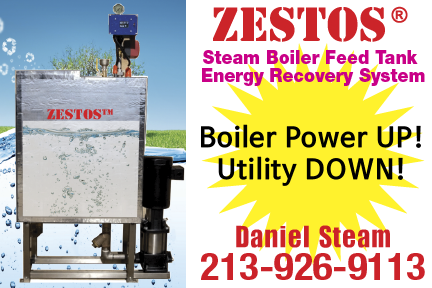Your boiler’s humble blowdown valves may be costing you big money. When these valves leak, superheated boiler water which you’ve already burned a lot of expensive fuel to generate, is flashing off as steam and venting to the atmosphere. About the only time anyone pays attention to these rugged valves is when they either can’t be opened or won’t shut properly. It’s a mistake to think if they just open or close, all is well; this is a very costly misconception. The very nature of what these valves are exposed during their operation; debris, grit, and sandy detritus come shooting across the valve disk and seat at velocities exceeding 60 mph. This is roughly the same as being sandblasted. It’s not surprising then, after years of use, they lose their ability to seal properly and slowly begin to leak.
 FINDING FAULTY BLOW-DOWN VALVES
FINDING FAULTY BLOW-DOWN VALVES
Fortunately, it’s a simple process to determine the condition of these valves by performing simple temperature measurements with that ever-handy laser thermometer. The following test procedure will provide a fairly accurate predictor of valve condition. Place a large black iron pipe fitting like a 1” tee on the floor of the boiler room that stays dry and isn’t near direct heating from the boilers burners; preferably near the blow-down valves. We’re going to use this fitting to measure the ambient temperature of the boiler room and compare it to the temperature measured near the outlet of the blow-down valve.
First, measure the temperature of the area about 2 feet downstream of the blow-down valve under test. Next, measure the temperature of 1” tee on the floor of the boiler room. There should be less than a 30 degree F. difference in temperature between the two points. If there is more, it’s likely an indication the blow-down valve is leaking.
WHAT TO DO ABOUT A LEAKY BLOW-DOWN VALVE
Some of the “Y” type globe blow-down valves have replaceable disks and seats. My experience has been that while it’s relatively easy to replace the disks, replacing the seats in this type of valve is far more challenging. Limited damage to the seat may sometimes be overcome by using a new Teflon disk. This is worth trying since replacing this type of valve is often an expensive job. If the blow-down valve is a ball type, to my knowledge it non-repairable. So, pray the pipefitter that installed the boiler located a union or two enabling an easy valve replacement. Peruse the paragraphs below for the proper technique in using the laser thermometer.
USING THE LASER THERMOMETER
The following paragraph explains the best technique to obtain accurate results.
1. The surface of the target should NOT be a highly reflective color like silver or white or have a highly polished finish like chrome or stainless. If it does, take a black Sharpie marker and blacken an area about the size of a quarter, use this blackened area as the target spot on the surface to be tested.
2. The laser pointer is normally used to select the target area and illuminates the center of the sensed area. Since the sensor itself measures all of the infrared energy entering the lens it becomes progressively more accurate the closer you place the sensor to the target area. When using the laser thermometer to run these tests be sure to position the lens of the thermometer slightly above the surface of the area being measured, don’t just aim it and use the laser pointer to take the temperature.
A NOTE ON BOILER VALVES
Valves used on boilers should be rated at the next higher level of the maximum rated boiler operating pressure. For example, if the rated operating pressure (usually found on the nameplate attached to the boiler) is 150 PSI then the valve would be steam rated for at least 200 PSI. This rating usually appears on the body of the valve after the SWP abbreviation for “steam working pressure” (you won’t find these valves at Home Depot or Lowe’s). THE NUMBERS FOLLOWING THE ABBREVIATION WOG stands for the pressure rated for use with water-oil-gas and is NOT THE RATING FOR STEAM SERVICE.

Bruce Grossman
Bruce Grossman is the Chief of R&D for EZtimers Manufacturing. EZtimers is the manufacturer of the new EZ DOSE boiler compound manager and return tank level control which replaces that troublesome ball float valve in the condensate return tank and automatically adds the correct amount of boiler compound to the return tank preventing the oxygen corrosion and scaling. Our SAHARA and DIB-M high purity separator water mister/evaporators provide a thrifty, legal method to get rid of the separator water generated by your dry-cleaning machine. See our Ad in this issue and for further information on EZtimers products visit www.eztimers.com Please address any questions or comments for Bruce to bruce@eztimers.com or call 702-376-6693.

